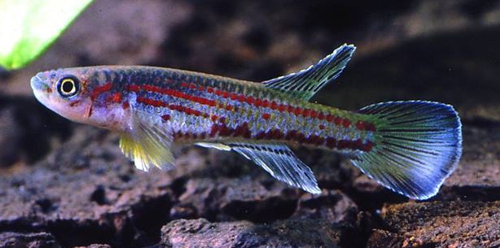Aphyosemion hofmanni Radda 1980

A.hofmanni GBG
93 / 17
Photo courtesy of Gottfried Marschitz
| Meaning of Name |
After Otto Hofmann, an Austrian aquarist who discovered the species with Ed Pürzl. |
|||||||||||||||
| First Description |
Radda A.C. 1980. Beschreibung zweier neuer Aphyosemion - Arten aus Süd Gabun. Aquaria 27 : 203 - 204, figure 3. |
|||||||||||||||
| Size |
4 cm (Radda & Pürzl 1987), 30.5mm (Holotype), 26-30mm (Paratypes). |
|||||||||||||||
| Meristics |
|
|||||||||||||||
| Karyotype |
|
|||||||||||||||
| Sub-Genus |
Aphyosemion |
|||||||||||||||
| Group |
hofmanni |
|||||||||||||||
| Synonyms |
|
|||||||||||||||
Populations
|
BBW 00/20 - BSWG 97/14 -
EBT 96/18 - 2·5 kms south of Takamoundjikou EBT 96/19 - GBG 93/17 -
GEB 94/14 - 35·5kms south of Mbigou. Same location as EBT 96/19. GEB 94/16 - GHP 80/12 - Iméno Mbila (Type locality).
GJS 00/8 - Takamogikou
- Collected in a stream named Boungoma.
Here were found a very handsome population of A.
joergenscheeli that later actually split out into two different
phenotypes - a very blue and a very red one. Here were also found a
very handsome and variable A.hofmanni.
Unfortunately this one did not make it to Europe, only 4 females survived
the trip. PEG 93/8 - 18kms north of Mbigou. TDK 97/8 - Mbono on the road between Mbigou-Malinga. |
|||||||||||||||
| Type Locality |
Collection point GHP 80 / 12 on the road from Mimongo (via Mokabou) to Mbigu near Iméno Mbila, 55 km from Mimongo. du Chaillu Massif, Ngounié Province, southern Gabon. |
|||||||||||||||
| Distribution |
Very small distribution area apparently restricted to the highest parts of the Massif in the Mbomi drainage. Closest neighbouring Aphyosemion is A.lamberti. |
|||||||||||||||
| Habitat |
Small mountain streams at an altitude of 600 metres. Water depth was often recorded at 1 cm (shallow areas appear to be their favourite habitat). Air & water temperatures taken at 0900 was 20'C. Sympatric sp. include - Aphyosemion ocellatum, Barb sp. Clarius sp. & Ctenopoma sp.
Collecting place of A.hofmanni & A.ocellatum Du Chaillu Massif, Gabon. Photo: Courtesy of Ed Pürzl. |
|||||||||||||||
| Distinguishing Characteristics | Spade shape caudal fin. Anal fin is distinctive with a pale blue band near the body & a wide yellow outer margin. Also, their is a dark band on the lower body from caudal peduncle to pectorals. | |||||||||||||||
| Colour/Pattern Variability | Low | |||||||||||||||
| History |
Originally collected by Purzl & Hofmann in 1980 from Imeno Mbila a small mountain stream on the road between Mimongo & Mbigu 55 km from Mimongo. Males only survived the trip back to Austria. The holotype & paratypes ( being 2 males, 7 females & 43 sub-adults are deposited in the Musee Royal de l'Afrique Centrale. Tervuren, Belgium. Radda considered this sp. to belong to the A.elegans group from meristic & morphological data but this was not taken up in various other articles. Only males survived the return journey to Austria. |
|||||||||||||||
| Breeding Notes |
Little has been written about this sp. but breeding may be similar to A.ocellatum. |
|||||||||||||||
| Diameter of Egg | ||||||||||||||||
| Remarks |
|